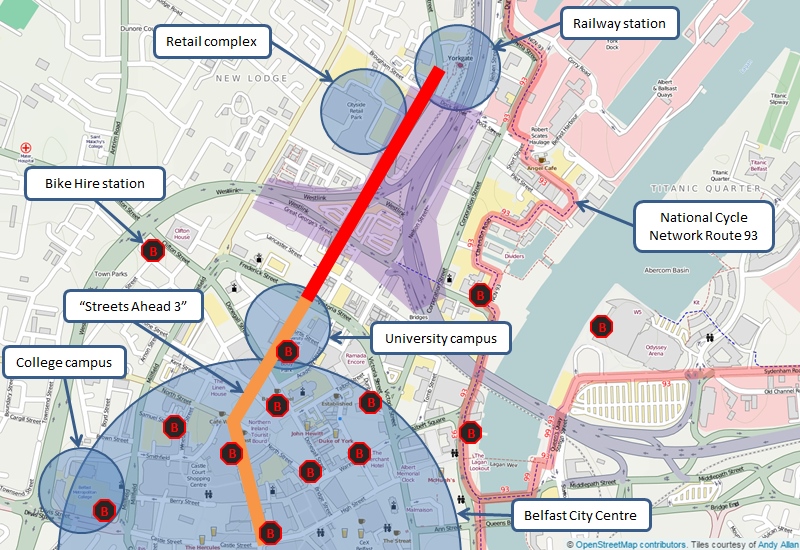
“We appreciate that many people feel that provision is frequently fragmented and of varying quality. Where ‘opportunities’ arise, i.e. provision of bicycle infrastructure as part of road maintenance or upgrade schemes we will seize these opportunities.”
(Draft Bicycle Strategy for Northern Ireland / DRD / August 2014)
Detailed plans have been released to inform a public consultation on the York Street Interchange, a £125m-£165m project to redesign the north quarter of Belfast’s traffic. It marks a key junction for the Department for Regional Development’s (DRD) cycling flirtations, with two ways to turn – allow past mistakes to be repeated, or start to back up active travel rhetoric with action.
The ASL continues to descend further into dangerous absurdity. This is not 'cycling infrastructure'. pic.twitter.com/akms8TYwWS
— GB Cycling Embassy (@GBCycleEmbassy) February 12, 2015
Instead of a standard-setting cycling corridor linking York Road with the city centre, poor design elements betray the typical bolt-on approach to cycling provision. Nothing less than the Department’s own Cycling Revolution™ itself is at stake if the heavy-hitting strategic road engineers continue to brashly ignore the needs of those who could choose to use the bicycle.

In short, the York Street Interchange (YSI) plan aims to remove the street-level bottleneck at the convergence of the M2 (to the north), the M3 (to the east) and the Westlink/M1 (to the southwest). Of most concern from a cycling perspective is the desperate lack of vision for the main ‘local’ spine of the project, York Street (highlighted in red on the map above) which would serve as a natural focal point for short to medium term cycle infrastructure plans.
It connects a number of key areas – the City Centre, the new Ulster University campus, a large shopping complex and the York Street Railway Station. There are a further 3 points to note when considering the project from an active travel perspective:
- Streets Ahead Phase 3 about to reshape the northern approach of the centre to enhance the urban environment for shoppers, pedestrians, cyclists and public transport users
- the woefully indirect National Cycle Network Route 93 skirts the edge of the YSI project area
- Belfast Bike Hire stations planned in a dense pattern, with future expansion to the north very likely if successful
“Dedicated cycling provision throughout the existing [YSI] area is limited. None of the existing road network currently has adjacent cycling lane provision, thus cycling journeys made through the existing junction arrangement are on-road and in direct interaction with local and strategic traffic.”
(York Street Interchange Preferred Options Report: Volume 1 / DRD / October 2012)
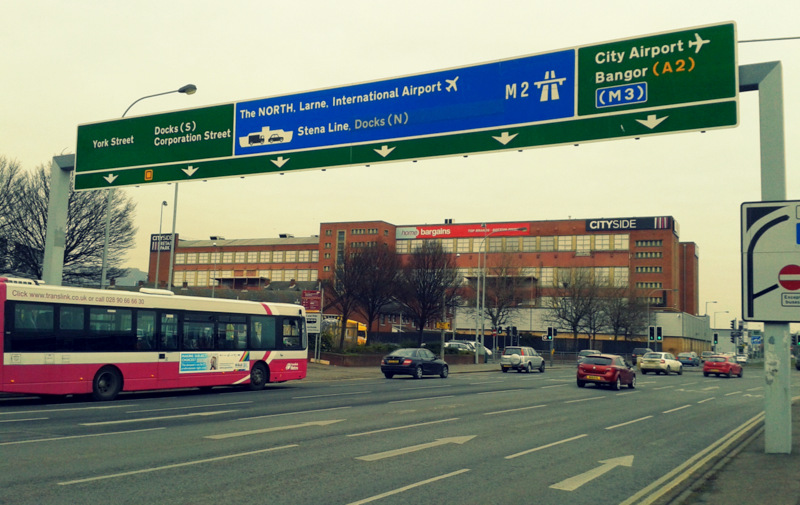
The current conditions for cycling are awful, with the 5 to 6 lane York Street forming the northbound section of a huge gyratory system. Traffic volume and speed make this desperately unattractive for cycling, and southbound journeys impossible without taking to the (deserted) pavements. The whole area is a tarmac jungle, long ago purged of vibrant street-level human activity.
But the YSI project offered some hope – after all, taking into account the usual physical constraints, DRD and their contracted designers have been working on a blank canvas. While the project objectives and designs may have pre-dated the Cycling Revolution™, we might expect to see something a little bit radical..
https://twitter.com/nigreenways/status/565159017019080704
..but instead we have the usual advanced stop lines, on-road cycle lanes (which the Chair of the All Party Group on Cycling Chris Lyttle referred to as “little more than a few of pots of paint”) and the coup de grâce – a shared bus and cycle lane. Because that’s what old-school road engineers think people riding bicycles in cities want, or certainly can be fobbed off with.
We’ll look later at the archaic cycling provision and compare with developing standards in other UK cities. But a more fundamental problem with the YSI plan lies in the power relationships inside DRD – what good is a Bicycle Strategy if those who design the blue riband strategic road schemes can simply bypass it?
“We will work with other Government Departments, District Councils, the voluntary and private sectors and other interested parties to ensure that the Strategy is fully and optimally implemented.”
(Draft Bicycle Strategy for Northern Ireland / DRD / August 2014)
Cross-Departmental cycling working groups have already been set up to ensure co-ordination of cycling activities across Northern Ireland government. But what about the toughest nut to crack – the vested interests within the Cycling Unit’s own Department? High quality cycling space is absent from the YSI project, including the crucial ‘local traffic’ bridge passing over the sunken motorway connections. Is this because it sits in another “silo” within DRD, which couldn’t give a fig about the “problems” of cyclists?
“I am very clear on where the boundaries of my scheme lie. I am very aware of project creep, because project creep relates to increased costs .. this cannot be seen as the answer to everyone’s problems for the whole of the area. We have accommodated the link through under the Whitla Street underpass, to provide for the linkage to one of the cycle route networks, so there are changes to that. We are consulting with our cycling colleagues to ensure that as far as possible we accommodate them. The reference to the “couple of cans of paint” on the York Street Bridge – I think there has to be a bit of an appreciation of the cost of widening that bridge to accommodate these. It is not insignificant to widen that bridge in those circumstances to provide an extra, say 1.5m on each side.” [my emphasis]
(Roy Spiers / DRD / at the Regional Development Committee, 19 February 2015)
[youtube https://www.youtube.com/watch?v=7pnqhz2fR1w?t=2h18m11s&w=800&h=450]
.
The language is instructive – this is a motorway scheme, a motor vehicle project, something to make car journeys faster. Pedestrians naturally have their footways, and the railway line is immovable, but cars, vans, trucks and motorbikes are the focus, the boundary limit. Decent cycling infrastructure? Improving access for cycling? Not part of the plan. A problem. An addition. Project creep. An unforeseen exception. Not something to be integrated into a £165m project, but a difficult, unreasonably costly (!) and frankly unwelcome accommodation.
By the way, you might consider that to be the biased view of a pro-cycling writer – but it’s writ large in the project brief..
#YSI plans *very explicitly* not meant to "improve" access for pedestrians and cyclists @roywhite_ni @Fearghal_Murray pic.twitter.com/aJgZvsgveQ
— NI Greenways (@nigreenways) February 12, 2015
What of that bridge which would have to be widened to “accommodate” the wild demands of the “cycling lobby”?
"Cost of widening the bridge [for cycling] is not insignificant"
It's a very wide bridge; the mindset is too narrow.. pic.twitter.com/BQhJwGKDCI— NI Greenways (@nigreenways) February 25, 2015
Cargobike Dad does an excellent job of reallocating the generous motor vehicle space on the bridge, but you only need to look at the real estate given over to “separation strips”. Keeping vehicles apart appears to have a higher priority than providing space for cycling. On questioning the representatives at the YSI public face-to-face consultation event, these 1.6m strips were described as “essential” for traffic lights. This despite the fact there are existing overhead gantries on the road, and another is planned for the new scheme.
Who’s asking for a widened bridge? No-one. That’s a handy bit of bluster to distract from engineers’ unwillingness to imagine that a good quality cycle route should, over time, reduce non-strategic vehicle traffic levels.
“We are committed to creating a network of high quality, direct, joined up routes. We want to make the bicycle an attractive, obvious mode of transport, and to help those who choose to cycle, by having high quality infrastructure which provides greater priority for the bicycle.”
(Draft Bicycle Strategy for Northern Ireland / DRD / August 2014)
It might be worth learning the lessons from the last bridge built over a strategic road in Belfast. Less than ten years ago and a mile away is the Grosvenor Road bridge, rebuilt as part of the Westlink upgrade. Dedicated cycling space wasn’t included, missing another “once in a lifetime opportunity” to remove a physical barrier between the City Centre and West Belfast with its terribly low cycling rates.
The Grosvenor Road flyover; why it is important to get the York Street Interchange right. http://t.co/j4zxPEQLPE pic.twitter.com/7arxB3ao7A
— Stripymoggie (@StripyMoggie) February 11, 2015
As it turns out some DRD engineers managing YSI also worked on the Westlink project. So who is advising the current “Strategic Advisory Group” on the active travel elements of the YSI project, to ensure history doesn’t repeat? Sustrans would be a safe and trusted option for DRD – again the language is instructive:
“The Strategic Advisory Group is a group of individuals who I have invited who, I feel, have a contribution to make to the aesthetics and integration of this. This carries on from a similar group that I had in place for Westlink. If I open this out to all and sundry I get nowhere, is the answer. Sustrans is not on the group. The thing is, I am there, I chair the group, I will be looking at the aesthetics, the integration, user appreciation of the route to ensure that if there is something that we can do to make it more user-friendly in any circumstances for non-motorised users, as well as motorists.” [my emphasis]
(Roy Spiers / DRD / at the Regional Development Committee, 19 February 2015)
That even a (relatively conservative) group like Sustrans isn’t permitted near this little silo in DRD speaks volumes for the chances of dragging blinkered road engineers into the 21st century.
“We aspire to become more like our European neighbours who have embraced the bicycle as simply ‘another mode’ of transport that is accessible, attractive, safe and desirable.”
(Draft Bicycle Strategy for Northern Ireland / DRD / August 2014)
Inconsistent route design
One of the key problems with any cycle route in Belfast (if we have such things) is inconsistency. Whether it’s cycle lanes disappearing at junctions, bus lanes marketed as cycling infrastructure or plainly dangerous design features, these are issues which need to be addressed in all forthcoming road schemes.
Here we have a northbound on-road cycle lane (whether it’s advisory or mandatory is not the point – only paint ‘separates’ bicycles and motor vehicles) and a southbound route largely shared with buses, taxis and motorcycles. It could be lifted from any arterial route in Belfast today where this pattern repeats – and has delivered shamefully low cycling levels to date.
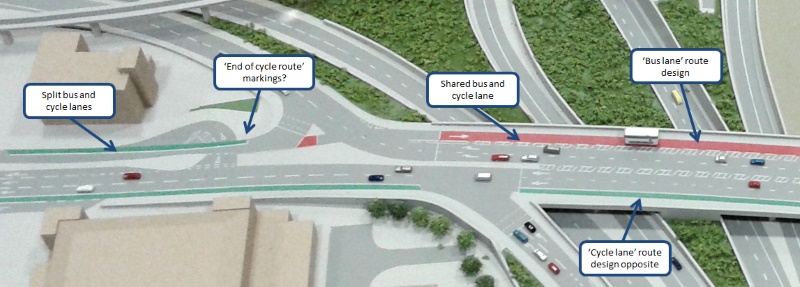
Where space exists beside the bus lane for a separate, dedicated cycle track, instead we have hatching where buses can apparently overtake cyclists safely and without causing intimidation. The lack of insight is par for the course.
No bus stop bypass
Cycling past the busy Cityside Retail Park means potential conflict with buses, which have to cross the cycle lane to reach the bus stop.
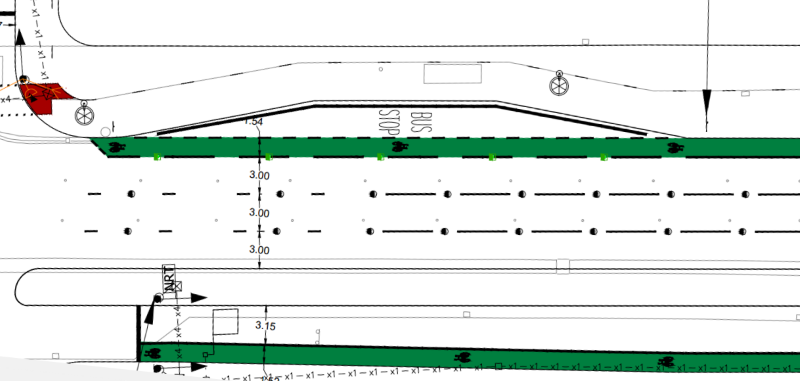
The bus stop bypass is a common design feature in The Netherlands, taking the cycle lane behind the bus stop to avoid conflict. It’s beginning to be rolled out in areas of the UK and Ireland where authorities are truly serious about cycling..
Did I mention 50m floating bus stop & cycle track? Already being used even before fully open. @BHCC_Transport pic.twitter.com/NMaUkVBa59
— Mark Strong (@ibikebrighton) November 5, 2014
Hanging cycle lanes
In quick succession bicycle users will face conflict actively designed into York Street – a left turn into the Cityside Retail Park followed by a left turn to Brougham Street (pictured below). The cycle lane continues across the turn, leaving a the cycle lane hanging between two lanes of motor traffic. This is plainly dangerous, and a massive barrier to inexperienced or nervous bicycle users.

It’s exactly the type of design one would expect the DRD Cycling Unit to be phasing out, in favour of international best practice.
ASLs everywhere
The advanced stop line cycle box – an easy stamp to show cycling has been catered for, while actually doing nothing to grow cycling levels. And the YSI designers have gone ASL-wild, with a desperately scatter-gun approach.
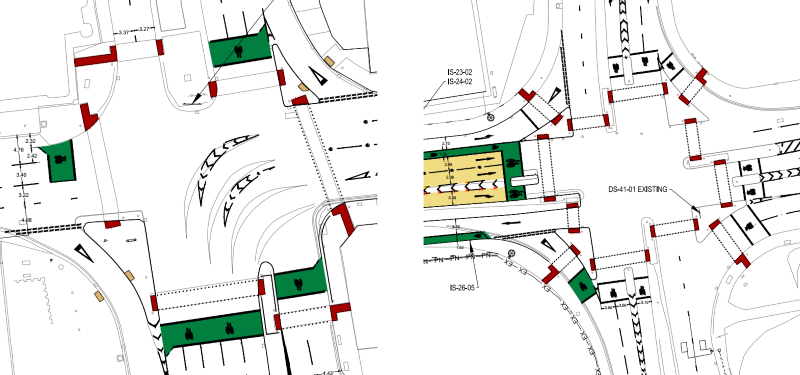
Some with lead-in cycle lanes, some without; some which are placed at the entrance to a road; one which place the braver cyclist into lanes which lead only to a motorway. There is even a monster ASL which is FIVE lanes wide – and didn’t the wider cycling world laugh at Belfast (it’s worth reading this entire thread for the disbelief) especially when the penny dropped that it already exists..
Punchline to the joke – the 5-lane ASL already exists (you learn something every day) @GBCycleEmbassy pic.twitter.com/JrXohxC5d3
— NI Greenways (@nigreenways) February 12, 2015
The ASL is a useless substitute for truly safe junction design, explained in simple terms here by Bicycle Dutch
Transport shift at the University
The importance of active travel at the new Ulster University campus seems to have been given very little attention. By 2018 over 15,000 students and staff will be based on the edge of the YSI site. A quick look at the various planning applications for student accommodation give enough cause for a major objection to the current YSI design. These five plans alone (listed on the excellent Future Belfast website) cater for over 500 bicycle parking spaces, vastly outnumbering the planned car park spaces. This is harsh reality clashing with DRD fantasy..
- 48-52 York St (200 rooms / 100 cycle spaces)
- 101-107 York St (694 rooms / 120 cycle spaces)
- 28-30 Great Patrick Street (529 rooms / 340 cycle spaces)
- 123-137 York St (407 rooms / unspecified cycle spaces)
- 37-41 Little Patrick St (50 apartments / unspecified cycle spaces)
“We want to be visionary in our approach and we want to embrace innovation. We are developing a long term strategy, spanning a 25 year horizon, to give us the chance to make Northern Ireland a cycling society.”
(Draft Bicycle Strategy for Northern Ireland / DRD / August 2014)
By 2040 the streets in this area should have good quality space for cycling in a dense grid suitable for users of all ages and abilities, linking in with a new bridge across the River Lagan and serving a growing, vibrant inner city population who will be less reliant on car transport. How much of this can be created cheaply and easily now on YSI’s blank canvas, instead of DRD having to return for a costly and disruptive (perhaps prohibitively so) retrofit later?
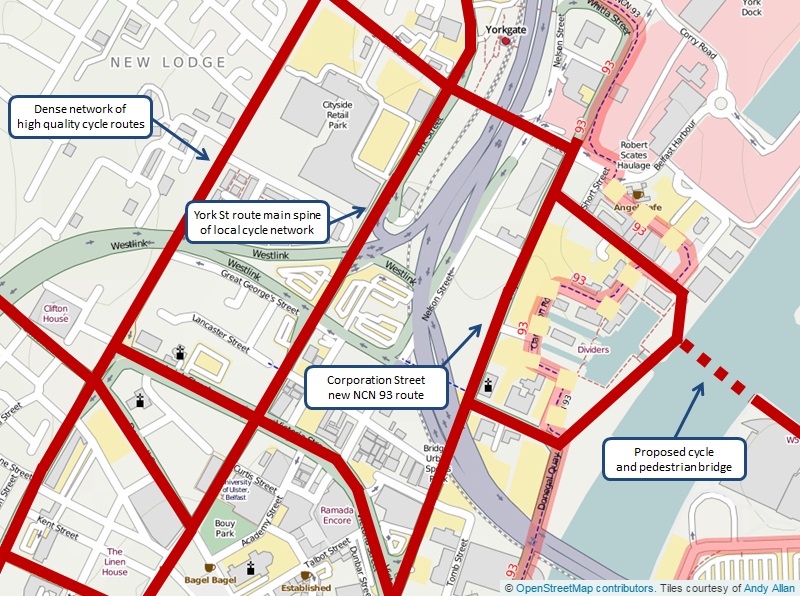
The Bicycle Strategy took flak for its inclusion of ‘types of cyclists’ which many pointed out could lead to just this type of patchwork design. Any engineer considering how to include space for cycling in the YSI plans should have only one user in mind – an 8 year old child. Get it right for them, and you get it right for everyone.
Whether with a peer group or with their family, ask yourself would an 8 year old feel confident and be safe to cycle through this area? If the answer is no, change the design to make it safe. If you’re wondering why an 8 year old needs to be cycling through a busy interchange, you are the impediment to necessary change.
From the initial aims and objectives of the project through to the delivery mechanisms, ploughing a huge road scheme through a city quarter and denying any responsibility to create benefits for non-motorised users is desperately arrogant. It’s time to hand the ‘local’ sections over to the DRD Cycling Unit which, both technically and politically, faces its first big test. I hope they can strike a decisive early blow for the Cycling Revolution™.
https://twitter.com/herbert_tiemens/status/572504496128966656
Send your views on the York Street Interchange project by the consultation closing date on Tuesday 10th March to:
The Divisional Manager
Transport NI – Eastern Division Headquarters
Hydebank
4 Hospital Road
Belfast
BT8 8JL
Or email to: roads.sriteastern@drdni.gov.uk
For more resources on the York Street Interchange try these sites: